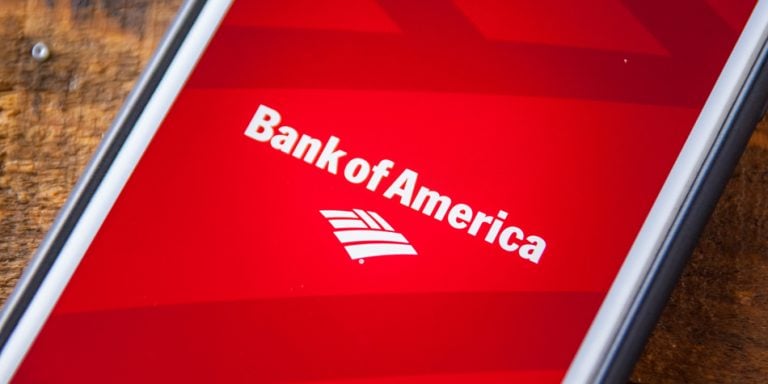President Donald Trump says a lot of things that he doesn’t mean. He said one of those things a few days ago, when he rattled the C-suites of America’s big banks — including Bank of America Corp (NYSE:BAC) — by threatening to break them up. Financial equities, including BAC stock, shrugged it off.
Bank of America CEO Brian Moynihan responded to Trump’s latest words on the subject calling it “crazy” and “against America’s interests.” While both of these assertions might be correct, investors who own Bank of America stock or are considering owning it ought to reflect on the pros and cons of such a move.
The phrase “be careful what you wish for” comes to mind, but so too does another one by Margaret Wheatley, an American writer, and organizational consultant:
“Without reflection, we go blindly on our way, creating more unintended consequences, and failing to achieve anything useful.”
Wheatley’s quote cuts both ways, but blindly accepting Moynihan’s arguments against a breakup plays right into the hands of the big banks who want you to think they are America’s best defense against financial crises.
Don’t get wrong, I’m a fan of BAC stock, although I don’t own it. I said as much in early April. However, I do think it’s prudent to examine both sides of this argument.
The Pros of a BofA Breakup
Let’s talk about complexity.
Have you ever read Bank of America’s 10-K from cover to cover? I hope not! Its 2016 version is 221 pages, and that doesn’t include its various supporting documents that accompany its annual filing.
It’s full of all kinds of numbers, data and legalese meant to comply with all the regulatory requirements of a large institution responsible for so many people’s hard-earned savings, so it’s only natural that the 10-K is this thick.
But I don’t think most people — including those who consider themselves financially educated — could make heads or tails of most of what’s in there. I have a tough time, and I spend all my waking hours scouring through these documents to find interesting angles for stories.
Warren Buffett is right that most people don’t know how to trade individual stocks and would be better off owning an S&P 500 index fund.

“Well, the big mistake is thinking they know when to buy and sell stocks,” Buffett told Yahoo Finance’s Andy Serwer in a May 3 interview. “Any attempts to pick the times to buy or sell, I think, are a mistake for 99% of the population. And I think that even attempts to pick individual securities is a mistake for people.”
Human nature being what it is, people are going to buy and sell individual stocks, whether it’s right for them or not, much like smoking, etc.
My point is this: By splitting Bank of America into two companies, with one holding the investment bank and the other the commercial bank, it’s possible that the regulatory filings of each of them would be easier for the average person to understand, making an educated decision a more realistic possibility.
I’m not saying that breaking up BofA into two companies will make both of them more efficient. However, given that many believe BAC stock is cheap despite its 70% run over the past year, significant value could be generated by two stocks telling a simpler story about themselves.
The Cons of a BofA Breakup
The sheer enormity of breaking up America’s big banks for many is incomprehensible. The time it would take to make this would be comparable to the years required to complete Boston’s “Big Dig” or a wall along the Mexican border.
“You don’t know what’s really behind (this statement),” Short Hills Capital Partners founder Stephen Weiss said on CNBC. “What I will tell you is this: it will take years to break up the big banks, so there’s really nothing to worry about now.”
So, while the Glass-Steagall Act existed for 66 years and looked after the best interests of American consumers by keeping investment banks separate from commercial banks, to put the genie back in the bottle is darn near impossible.
The argument most make for the Bank of Americas of the world is one in which scale is the critical element for supporting American companies participating on a global basis. You have to be BofA big to make the multibillion-dollar loans required by today’s multinational.
Here in Canada where I live, the big banks — there are five, six if you include National Bank of Canada (OTCMKTS:NTIOF) — are the envy of bankers around the world.
In 2014, the International Monetary Fund published the Global Financial Stability Report, an examination of the global banking system. It found that Canada’s three largest banks controlled more than 60% of Canada’s banking assets while the top three in the U.S. controlled 45% of America’s banking assets.
We Canadians feel protected by such huge institutions. Moynihan would argue that BofA, and the rest of the big banks, provide the same level of comfort for Americans.
Bottom Line for BAC Stock
I agree with Ken Griffen on this issue.
“Would I argue to break these banks into many, many small banks? No,” Griffin said in a recent interview with Bloomberg TV. “But should we think about separating the investment banks from the commercial banks, a new Glass-Steagall? I would be really excited to see that. I think it would be great for the economy.”
More importantly, I think it would be ideal for BAC stock because the value of both its investment bank and commercial bank as separate entities could be worth more than they are together under one roof.
Furthermore, I don’t think the big banks are passing on the savings from economies of scale to their customers, so average Americans benefit little from the added size.
Mr. Moynihan, it won’t happen, but it should.
As of this writing, Will Ashworth did not hold a position in any of the aforementioned securities.
